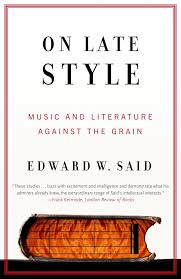Gould and Bach
Reading: On Late Style: Music and Literature Against the Grain (2006) by Edward Said
[….] A justly celebrated essay published by Adorno in 1951— "Bach Defended Against His Devotees"—formulates some of what I have been suggesting about Gould in terms of a contradiction lodged at the very heart of Bach’s technique, namely, the connection or link between counterpoint or "the decomposition of the given thematic material through subjective reflection on the motivic work contained therein" and "the emergence of manufacturing, which consisted essentially in breaking down the old craft operations into its smaller component acts. If this resulted in the rationalization of material production, then Bach was the first to crystallize the idea of the rationally constituted work … it was no accident that he named his major instrumental work after the most important technical achievement of musical rationalization. Perhaps Bach’s innermost truth is that in him the social trend which has dominated the bourgeois era to this very day is not merely preserved but, by being reflected in images, is reconciled with the voice of humanity which in reality was stifled by the trend at the moment of its inception."3
I doubt that Gould had read Adorno or even heard of him, but the coincidence between their views is quite striking. Gould’s Bach playing bears the inflections of a profound—and often objected to—idiosyncratic subjectivity, yet is paradoxically presented in such a way as to sound clear, didactically insistent, and contrapuntally severe, with no frills. The two extremes are united in Gould as, Adorno says, they were in Bach himself. "Bach, as the most advanced master of basso continuo, at the same time renounced his obedience, as antiquated polyphonist, to the trend of the times [gaudium, or style galant, as in Mozart], a trend he himself had shaped, in order to help it [music] reach its innermost truth, the emancipation of the subject to objectivity in a coherent whole of which subjectivity itself was the origin" (BDA 142).
The core of Bach is anachronistic, a union of antiquated contrapuntal devices with a modern rational subject, and this fusion produces what Adorno calls "the Utopia of the musical subject-object." So to realize Bach’s work in performance means that "the entire richness of the musical texture, the integration of which was the source of Bach’s power, must be placed in prominence by the performance instead of being sacrificed to a rigid, immobile monotony, the spurious semblance of unity that ignores the multiplicity it should embody and surmount" (BDA 145). Adorno’s attack on fraudulent period-instrument authenticity is not to everyone’s taste, of course, but he is absolutely right to insist that what in Bach is inventive and powerful should not be squandered or sent back to the sphere of "resentment and obscurantism;” Adorno adds that the "true interpretation" of Bach’s work is "an X-ray of the work: its task is to illuminate in the sensuous phenomenon the totality of all the characteristics and interrelations which have been realized through intensive study of score…. The musical score is never identical with the work; devotion to the text means the constant effort to grasp that which it hides" (BDA 144).
In this definition of it Bach performance becomes both disclosure and heightening, in which a particular kind of inventiveness in Bach is taken up by the performer and reformulated dialectically in modern terms. The heart of this kind of playing is Gould’s amazingly prescient and almost instinctive understanding of Bach’s creativity as manifested in a kind of polyphonic writing that is both virtuosic and intellectual in the discursive sense at the same time. For a brief explanation of what I mean, I have relied on a study entitled Bach and the Patterns of Invention published in 1996 by Laurence Dreyfus. In my opinion Dreyfus pioneers a new level of understanding of Bach’s basic creative achievement and in so doing transforms our appreciation of what it is that Gould himself as performer was able to do. It is a pity that Dreyfus nowhere mentions Gould because the common element for both of them is the word invention, which Bach himself used and which Dreyfus correctly relates to a rhetorical tradition going back to Quin-tilian and Cicero. Inventio has the sense of rediscovering and returning to, not of inventing as it is used now—for example, the creation of something new like a lightbulb or transistor tube. Invention in this older rhetorical meaning of the word is the finding and elaboration of arguments, which in the musical realm means the finding of a theme and developing it contra-puntally so that all of its possibilities are articulated, expressed, and elaborated. Much used by Vico, for example, inventio is a key term for his New Science. He uses it to describe the inge-nium, the ability to see human history as something made by the unfolding capacity of the working human mind; for Vico, therefore, Homer’s poetry should be interpreted not as the sage wisdom of a rationalist philosopher but as the inventive outpourings of a necessarily fertile spirit, which the later interpreter is able to recover inventively by putting her- or himself back into the mists and myths of Homer’s very early time. Invention is therefore a form of creative repetition and reliving. This idea of interpretation and poetry as invention can be given a musical extension by looking at the special quality of Bach’s polyphonic composition. His remarkable gift for invention in his fugal writing was to be able to draw out of a theme all the possible permutations and combinations implicit in it that, through skillful practice, he could make it undergo as an object presented to the composing mind, like the material of Homer’s poems, for skillful performance and invention. Here is how Dreyfus puts it:
Rather than conceiving musical structure as unconscious growth—an aesthetic model that presumes a spontaneous invention beyond the grasp of intentional human actions— I prefer to highlight the predictable and historically determined ways in which the music was "worked on" by the composer. This intention to speculate on Bach’s willfulness invites us to imagine a piece of his music not as inevitably the way it is, but rather as the result of a musicality that devises and revises thoughts against a resilient backdrop of conventions and constraints…. [W]hile it is true that parts and whole in Bach cohere in a way that is often just short of miraculous … I find it more profitable to chip away at musical "miracles" … pursuing instead Bach’s inclination to regard certain laws as binding and others as breakable, to accept certain limits as inviolate and others as restrictive, to judge certain techniques productive and others fruitless, and to admire some ideas as venerable while regarding others as outmoded. In brief, … analyses that capture Bach as a thinking composer.4
Thus Bach’s gift translated itself into a capacity for inventing, creating a new aesthetic structure out of a preexisting set of notes and an ars combinatoria that no one else had the skill to use so outstandingly. Let me again quote Dreyfus here in connection with what Bach was doing in The Art of Fugue:
Examining these pieces from the vantage point of the many different kinds of fugal invention, it is striking how, within the context of a monothematic work, Bach was never concerned with providing "textbook" examples of the subgenres, which might conceivably have laid out the disposition of each piece in an exemplary and justifiable order. Typically, he crafted instead a set of highly idiosyncratic pieces that show how very far fugal invention can be pursued in the quest for harmonic insights…. This is why the Art of Fugue pieces so often go out of their way to frustrate pedagogically-oriented definitions of fugal procedures at the same time that they assert the preternatural status of fugal procedures as a source of the most inspired inventions.5
On Late Style: Music and Literature Against the Grain (2006) by Edward Said



